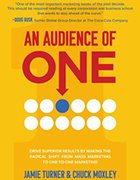Advice for marketing personalization
Business professionals have become numb to the plethora of marketing emails they receive every day. However, personalized messaging can grab their attention.
B2B marketers can benefit from a personalized approach just as much -- if not more -- than B2C.
Advancements in technology have altered the way brands target audiences and find leads. Marketers had limited access to customer data before the internet, so they had to advertise through channels like TV and billboards. Although these channels can generate brand recognition, they're less effective than one-to-one or personalized marketing, because many of the people they reach have no use for the product. Personalized marketing, on the other hand, focuses on customers most likely to get value from a product.
In the book, An Audience of One: Drive Superior Results by Making the Radical Shift from Mass Marketing to One-to-One Marketing, authors Jamie Turner and Chuck Moxley explore how brands are increasingly adopting personalized marketing strategies to better understand customers and boost sales.
Here, Turner and Moxley discuss the benefits and challenges of personalized marketing, along with important tips for B2B marketers.
The following interview was edited for length and clarity.
How does one-to-one marketing differ from traditional marketing?
Jamie Turner: In essence, one-to-one marketing is about hypertargeting and personalizing campaigns as much as possible. Back in the 1950s, we used to have broadcasts where we would target people on TV based on the demographics of the people watching the show. Then, in the 1960s, we moved to direct response marketing, where we began to use data to target people mostly through direct mail. Then, you move into the 1990s and early 2000s, and you get behavioral targeting, which targets people based on their online behaviors.
Now, we're in the era of one-to-one marketing, where we can take all the technologies from the 1950s up to today and combine them with non-personally identifiable data to target customers while making an effort to protect their privacy.
Why do customers prefer a one-to-one marketing approach?
Turner: Intrusive ads can create a poor opinion of the brands being advertised. Well, what is an intrusive ad? It's an ad that is not relevant to you. … It's not something that you're interested in, and it actually makes you have a negative opinion of the brand. People want ads that are relevant to them. And that's what one-to-one marketing helps you do.
What are the drawbacks to a one-to-one marketing approach?
 Jamie Turner
Jamie Turner
Turner: The main thing is [that] at the same time we're getting more personalized with our advertising, people are gaining a greater desire for protecting their privacy. The good news is the data that we use to hyper target you has been anonymized, because no brand … wants to be the next Cambridge Analytica.
Instead, they take great pains to anonymize the data. You're just a digit to one-to-one marketers. You're 17543-B. That's what we're targeting. So, people are nervous about it, but they also recognize it's what you have to pay in order to get free information.
How does one-to-one marketing differ in B2B than in B2C?
Chuck Moxley: There's a lot of similarities between the two. For instance, while people are making buying decisions for their company, they're still people. The difference is there's a lot more people involved in the B2B decision process, and there's a lot more risk. Choosing a bargain brand of detergent is a lot different than choosing a $50,000 CRM system.
 Chuck Moxley
Chuck Moxley
B2B purchase decisions are highly considered -- very rarely does someone make a B2B purchase on impulse. So, in B2B we interact with buying committees, and when you're doing outreach to them, you've got to be reaching out to eight or 10 people in a company.
At the same time [that] our households are getting less junk mail because the cost of postage has gone up and the effectiveness has gone down, in B2B, we get so much more outreach. Therefore, we've become kind of numb to it. I probably get 30 or 40 marketing emails per day. The thing that will cause me to stop and pay attention is if it's personalized.
So, if somebody in the first sentence of the email says, 'Hey, I read your book, and I think it's great,' I'm going to open that email. If the person says, 'Hey, I hope you're having a great day, I want to tell you about my new product,' I'm not opening the email.
How can B2B organizations create an ideal customer profile (ICP)?
Moxley: To develop an ICP, my team looked at which customers used the most features in our product, which ones would most likely sign a five-year renewal, and which are seeing the greatest ROI -- things like that. That's how we identified six things that our top customers had in common: They spend heavily to acquire customers, their websites have a million or more page views, their sites are transaction-focused, etc. Most of these criteria you can go by data on, but some require manual research.
We actually use these criteria to calculate an ICP score. We have all the fields for [ICP criteria] in our CRM. So, as we're researching target companies, we fill that data in, and it calculates a score. Also, we can rank ICPs tier one, tier two and tier three. We give more credence to tier one versus tier three. A company that's an ICP but not in those top tiers means it's somebody we could sell to, but they're not going to get the maximum value out of our product.
We just put in place a minimum contract requirement of $50,000, too, because we were getting deals for $10,000 that were taking as long as deals for $150,000. That's really extreme, but it's that idea of rather than trying to sell to everybody, figure out which companies your product or solution is best built for.
Editor's note: TechTarget offers ABM and project intelligence data, tools and services.








